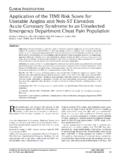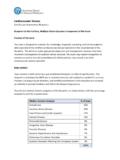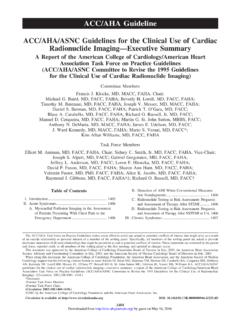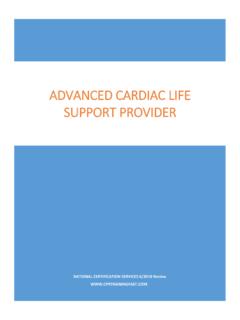Transcription of ACUTE CORONARY SYNDROME ANAESTHESIA …
1 Sign up to receive ATOTW weekly - email ATOTW 210 ACUTE CORONARY Syndromes, 24/01/2011 Page 1 of 7 ACUTE CORONARY SYNDROME ANAESTHESIA TUTORIAL OF THE WEEK 210 24TH JANUARY 2011 Katrina Webster, Staff Specialist Anaesthetist Royal Hobart Hospital, Tasmania, Australia Correspondence to QUESTIONS Before continuing, try to answer the following questions. The answers can be found at the end of the article, together with an explanation. 1. Which of the following statements is correct? a. ACUTE CORONARY SYNDROME patients include those with unstable angina and all types of myocardial infarction. b. ACUTE CORONARY SYNDROME patients include those with stable angina. c. Myocardial infarction causes serum cardiac enzymes to be raised. d. It is possible to have a myocardial infarction without having ECG ST segment changes.
2 2. What signs and symptoms might indicate a diagnosis of myocardial infarction? 3. Which of these systems have been used to predict cardiac risk? a. Lees cardiac risk index b. Detsky cardiac risk index c. Eagle cardiac risk index d. Goldman cardiac risk index e. ACC AHA guidelines f. All of the above 4. How would you manage a patient you suspect is having an intraoperative myocardial infarction? DEFINITIONS ACUTE CORONARY SYNDROME (ACS): unstable angina or myocardial infarction with or without ST segment elevation on ECG. Unstable angina: myocardial ischaemia of increasing duration or severity in the absence of cardiac myocyte necrosis. ST segment elevation myocardial infarction (STEMI): myocardial necrosis (evidenced by raised cardiac enzymes on blood test) with ST segment elevation on ECG.
3 Non-ST segment elevation myocardial infarction (NSTEMI): myocardial necrosis (evidenced by raised cardiac enzymes on blood test) with no ST segment elevation on ECG. CLASSIFICATION IS IMPORTANT Distinction between angina, unstable angina, NSTEMI and STEMI is clinically relevant for several reasons. The prognosis is progressively worse for each clinical group. The STEMI group have the poorest prognosis, with one third of this group dead within 24 hours of onset of ischaemia. Sign up to receive ATOTW weekly - email ATOTW 210 ACUTE CORONARY Syndromes, 24/01/2011 Page 2 of 7 Treatment is different depending on the clinical classification. Patients with STEMI are treated with urgent attempt at reperfusion. Percutaneous CORONARY intervention is the preferred treatment if available.
4 ACS patients not having a STEMI are generally not rushed to urgent reperfusion procedures. They are often stratified into low and high risk groups. Medical management is optimized and some are considered for reperfusion treatment. RISK FACTORS The two most significant risk factors for developing CORONARY vessel atherosclerosis are increasing age and male gender. Other risk factors include cigarette smoking, hypertension, obesity and sedentary lifestyle, high cholesterol, diabetes mellitus, family history of premature CORONARY artery disease. PATHOPHYSIOLOGY Atherosclerosis has multiple pathological processes. CORONARY arteries become stenosed over time with lipid rich atheroma deposited in the sub-endothelial layer. An initial tissue injury and accumulation of macrophages at the area leads to plaque development.
5 Eventually the plaque includes a macrophage rich lipid core covered by a protein fibrin mesh cap. Plaque deposits tend to accumulate around bifurcations of arteries, and cause symptoms once the lumen diameter is reduced by over fifty percent. Blood flow is compromised when the lumen is blocked by a combination of vessel plaque, thrombus and inflammatory mediators. Thrombus formation can occur when plaques rupture or ulcerate causing exposure of tissue factor and initiation of clotting at the site. Glycoprotein IIb/IIIa receptors on platelets are activated causing growth and stabilisation of the thrombus. Chemical mediators include collagen, adrenaline, adenosine, and serotonin. Thromboxane A2 is a potent vasoconstrictor and its release further compromises blood flow.
6 Inflammation is increasingly becoming recognised as a major factor. Inflammatory cells are present in plaques and are important in the cascade of events leading to plaque rupture. Inflammatory markers such as C-reactive protein and fibrinogen are increased in people at high risk of ischaemic heart disease. Plaques that rupture and lead to ACUTE CORONARY occlusion ( STEMI) are rarely large enough to occlude the vessel by plaque alone. Flow restrictive plaques that cause angina are less likely to rupture. Abrupt decrease in luminal blood flow causes STEMI. Occasionally STEMI can occur from ACUTE spasm of the CORONARY artery or CORONARY artery embolus. DIAGNOSIS A clinical history of worsening angina or new chest pain is common.
7 Pain may also be reported in the neck, jaw, arms and back. Symptoms may include: sweating, feeling generally unwell, fatigue, dyspnoea and nausea. A typical description of crushing central chest pain is not always given, indeed as many as half of all myocardial infarctions are clinically silent. A silent myocardial infarction is much more likely in patients with diabetes mellitus. Diagnosis of ACUTE myocardial infarction requires at least two of the following; 1. chest pain 2. electrocardiograph (ECG) changes consistent with myocardial infarction. 3. increase and decrease of serum cardiac enzymes. Every patient with suspicious symptoms or clinical history should receive timely assessment, ECG and serum cardiac enzyme evaluation. These tests can confirm STEMI or NSTEMI, but if negative do not necessarily exclude a diagnosis of ACS.
8 Further assessment by a cardiologist and exercise stress testing, pharmacological stress testing, or CORONARY angiography may be required. Sign up to receive ATOTW weekly - email ATOTW 210 ACUTE CORONARY Syndromes, 24/01/2011 Page 3 of 7 Diagnosis of ACS in an unconscious patient under ANAESTHESIA can be more challenging. Here the anaesthetist is guided by clinical history, relevant risk factors, physical examination, and intraoperative monitoring (including ECG and haemodynamics). Trends in filling pressures and cardiac output can be useful if a pulmonary artery catheter is present. Transoesophageal echocardiography (TOE) is very sensitive for detecting ACUTE segmental wall motion abnormalities and can be detected before ECG changes occur.
9 TOE is a very useful intraoperative procedure in the patient at high risk of intraoperative ACS. Table 1: Diagnosis of myocardial infarction TREATMENT General principles It is critical to urgently assess the patient and commence treatment. The general principles are to improve myocardial oxygen supply and minimise oxygen demand. Oxygen supply can be increased by adequate ventilation, adequate oxygenation, low normal heart rate and normal haemoglobin. Oxygen demand can be decreased by maintaining low normal heart rate, maintaining normal blood pressure, avoiding shivering, avoiding acidosis and treating sepsis. Good initial and subsequent management can prevent angina from progression to MI, and prevent MI from progression to massive MI.
10 Initial management Timely patient assessment is imperative. This includes administration of supplemental oxygen, assessment of haemodynamic stability and obtaining a twelve lead ECG. Pain relief with morphine and GTN are important to decrease preload and catecholamine release and hence minimise myocardial work. Aspirin is administered to minimise further clot development. Patients who are intolerant of aspirin can be given an ADP receptor antagonist such as clopidogrel. Subsequent management The focus of subsequent treatment is to re establish CORONARY perfusion as soon as possible. The patient must be carefully monitored with continuous ECG looking for development of dysrhythmias. There are medical, surgical and cardiac catheter interventional treatments available.
















